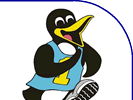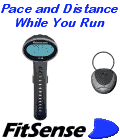The "Right" Shoe for You
Whether you're a new runner or an experienced runner,
buying the correct shoe is probably the most important decision
you will make. What's more, it's a decision that you have to make
over and over. A shoe that works for the first six months of your
running life may not work as you improve, get faster, or start running
longer distances.
The correct shoe will enhance your natural stride
and will help prevent injuries. It will allow your foot to strike
the ground, move through its running motion, and push off with ease
and in perfect harmony with your hips and knees.
The wrong shoe can turn running into a torturous
routine of pain and recovery. The wrong shoe will force your foot
out while your knee goes in, which is almost exactly the point at
which your hip goes out. The wrong shoe sets up a battleground in
your body between your muscles and tendons and bones and joints
and can end your running program in a matter of days.
The problem becomes even more complex because there
is no single shoe that is right for every runner. The activity of
running, or at least getting started as a runner, would be much
easier if you could just drop by the shoe store and buy a generic
pair of beginner's running shoes. But our feet, our bodies, and
our budgets are all different.
There are, however, some general guidelines. These
descriptions are not intended to be the definitive word on foot
motion and shoe construction. They are intended to help you avoid
that moment of embarrassment and the feeling of abject ignorance
that I had with the young shoe salesman. They are intended to allow
you to ask the right questions.
- Pronation:
- This is the foot's natural tendency to roll inward as you run.
The perfect foot begins the running or walking motion somewhat
on the outside of the heel and rolls inward toward the ball of
the foot.
- Overpronation:
- This is what happens when the foot rolls inward too far. The
beginning of the running motion often is fine, but the foot continues
to roll inward too far, beyond the ball of the foot.
- Supination:
- This refers to what happens when the foot does not roll inward
enough. As you walk or run, the striding motion occurs entirely
along the outside of the foot.
- Oversupination:
- This is what happens when the foot rolls outward too much as
it moves through the running motion.
What does all of this mean? What good is it to
know these words if you don't know why you need to know them? How
can you tell which labels apply to your feet and your running stride?
next...Your Foot >>
|
















